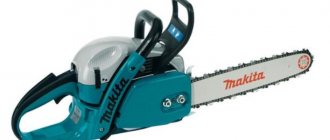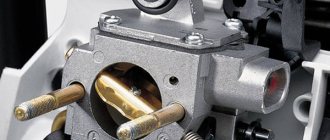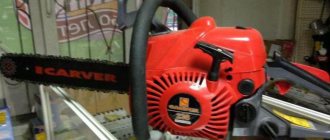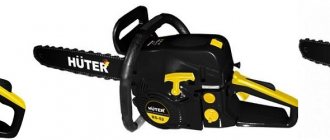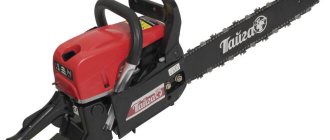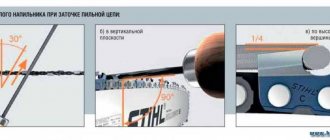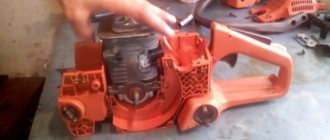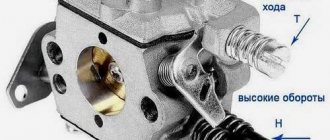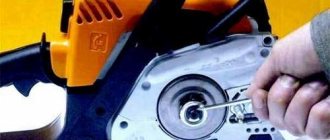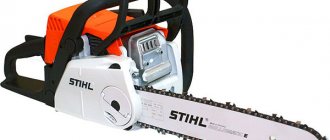Preparing and starting the saw
The handle that controls the throttle, simply called the gas button, is located on the back of the handle.
To avoid accidentally starting the engine, when pressing the gas button, you need to release the lever - the throttle lock, located on top of the handle. There is a chain catcher located at the bottom of the saw; in the event of a chain break, it catches it, protecting the operator from serious injury. Using the stop button, also called the ignition, you can quickly turn off the engine; it is located in a convenient place. The chain brake handle can be activated in two different ways. Method number one is manual, you only need to push the brake handle forward, the second method is inertial, in case of a reverse impact during a rebound. You will need to make sure that the chain is properly tensioned so that it is not too tight, but also does not hang from the tire. The newly put on chain needs to be tightened after operating the chainsaw for some time.
When starting the chainsaw engine, place it on a flat surface; the area under the tire should be cleared of foreign small objects. Having set the chain brake to the ON position, move the inertia brake handle forward and press the “smart start” button, if this function is present. When starting an unheated, cold engine, always close the air damper completely by pulling the regulator towards you.
The right foot steps with its toe on the bottom of the rear handle. Holding the upper handle with your left hand, with sharp but moderately strong movements we pull the starter cord by the handle, and continue until the engine shows the first signs of starting. Now the damper needs to be fully opened by pushing in the regulator. We continue to pull out the starter cord. It will be enough to make two or three jerks for the saw to start. Press the gas button once, after which the engine should stop idling.
To start a running and warm engine, there is no need to use a choke. All other moments when starting the saw will be exactly the same. It happens that it is difficult to start the saw even on a well-heated engine; you need to pull out the regulator all the way, just as you did when you started a cold engine, but then immediately push it back.
After starting the chainsaw engine, you do not need to remove the chain from the handbrake until you start working
It will be important to check the chain for lubrication. You will need to use some kind of light plane, be it a stump, paper or a light rag
We increase the chain speed a little, a path of engine oil is formed, which will indicate a sufficient oil level in the saw tank.
Try to hold the chainsaw firmly with both hands, all fingers should completely cover both handles. To minimize the force of kickback, the left hand should completely wrap around the foregrip with the thumb pointing straight down. You should never be afraid of the saw; the closer you hold it to your body, the less you will feel the actual weight of the saw. Better balance and control of the instrument will be maintained.
When moving from one place of work to another, you need to be sure that the chain is in a stationary position. To do this, always apply the chain brake, or better yet, stop the engine. When moving over even longer distances, put a protective cover on the bar, this will protect you from accidental injury and help protect the chain itself. After finishing work, it is recommended to drain the gas mixture and store the chainsaw with a dry tank.
It is important not to forget that the gasoline mixture is prepared for 7 to 10 days of maximum use. The mixture has its own shelf life and after 7 - 10 days it loses its properties
Chainsaws differ slightly in design features, but in most cases the assembly principle follows two standard schemes. For many devices, the instructions contain information about the need to activate the emergency brake before starting the startup procedure.
You must first master the structure of the plant and study the basic methods of correcting breakdowns, then a person will have the opportunity to fully operate the device.
How to cut with a chainsaw correctly
To operate a chainsaw correctly, you need to follow the basic recommendations:
- Keeping the saw close to your body will help maintain balance.
- Spread your legs wide apart and bend your knees.
- Keep your back straight.
- Before moving to a new location, you need to turn off the engine by activating the brake.
We suggest you familiarize yourself with Frozen beets and what you can cook from them.
Protective clothing will help protect you from accidental cuts. You should wear a protective helmet with a mask on your head, thick gloves for your hands, a padded suit for your body, and sturdy shoes for your feet.
How to start a chainsaw correctly: instructions
Let's look at the main steps that need to be followed in order to properly start the Stihl chainsaw.
- Before starting, the chain brake must be activated. It is activated by pressing it forward (as shown in the photo).
- Remove the protective cover from the tire.
- If the model has a decompression valve, it should be set to the on position, which will make it easier to start the tool’s motor.
- Press the fuel pump to reduce the number of pumps and make starting easier.
- The combination lever must be turned on in cold start mode. To do this, you need to lock the gas lever and press the combination lever all the way down.
- Before starting the system, it is necessary to ensure a level surface. In this case, the cutting part must be at a distance from the ground, otherwise it will become dull when starting.
- Hold the tool with both hands and keep it on the ground. The left hand should be on the chainsaw handle, and the right hand should be on the starting cable. Secure the tool with your right foot by stepping on the rear handle.
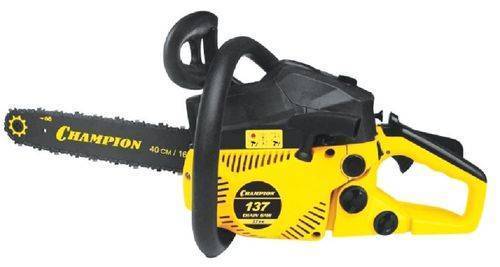
- Gently pull the starter rope with your right hand until you feel strong resistance. Using force, pull the starting rope several times, starting the engine briefly. In this case, to avoid abrasion, it is recommended to pull the cable upwards from the body.
- After a short start, the engine stalls. Now move the combination lever up one click. The lever should take the half-throttle position.
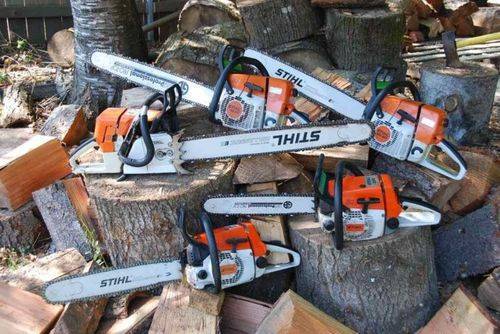
- Pull the starter cord again to start the chainsaw engine.
- When the engine is started by briefly pressing your finger, operate the throttle lever. The combination lever will automatically return to idle speed.
- Without touching the gas lever, move the chainsaw.
- Pull the handle towards you to release the chain brake. The position of the left hand remains unchanged, the hand is on the handle. The chain will be unlocked after the appropriate click.
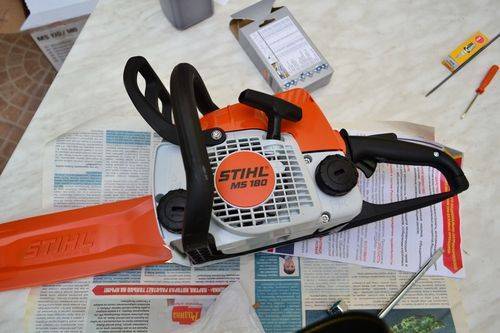
You can see a detailed description on how to start a chainsaw correctly in the video. Using these detailed instructions, you can gain skills on how to start a chainsaw.
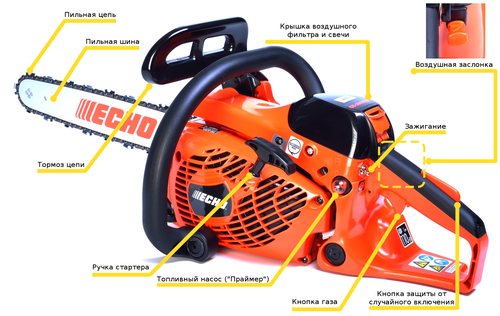
What to do if the chainsaw does not start?
But what to do if all the steps specified in the operating instructions have been followed, but the chainsaw still does not start? Regardless of the manufacturer of the chainsaw - Shtil, Husqvarna, Partner, Ural, Druzhba - a number of general activities can be identified for the tool factory.
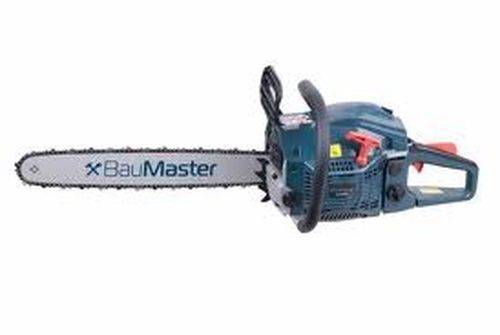
Below are practical tips from professionals that have been tested in practice and have proven effectiveness:
- Don't be nervous and don't try to adjust the chainsaw's carburetor.
- Set the instrument aside and let it rest. The reason may simply be that the candles are flooded. Give them a chance to dry.
- Take the instruction manual. Try starting the saw again. There is no need to turn on the saw brake.
- If this does not help, try removing the cover from the chainsaw body and removing the air filter. This way you can check the cleanliness of the filter and at the same time make the starting process easier.
- Replace the spark plugs. If it is not possible to install new spark plugs, you can use the old ones by first removing and calcining them.
- If a strange, pungent odor appears, it means that excess fuel has entered the chainsaw engine. To correct this situation, you need to remove the spark plug and, turning the saw over with the hole down, drain the excess. Without returning the saw to its normal position, sharply pull the starter several times. This way you will ensure that combustion products leave the chamber. The spark plug must be wiped dry and calcined, and then screwed in again and started without installing the filter.
- It is necessary to check the surface of the piston for the presence of fuel. If you unscrew the spark plug and notice through the hole that it is dry inside, you need to inject some fuel into the chamber using a syringe. The cause of problems in this case may be a blockage that interferes with the supply of fuel to the engine. If the engine can be started with a small amount of fuel, then the thrust will clear the blockage and the problem will be solved.
- The last two actions can be performed only if the candle is dry.
- Check the starter for serviceability. It is impossible to start a chainsaw without a starter.
- Check the ignition unit for spark.
- Try carefully removing the tool's muffler and starting it without it.
Each saw has its own manufacturing characteristics. You can watch the video on how to start a Husqvarna chainsaw. Follow the instructions carefully and the saw will serve you for a long time.
How to hold a chainsaw correctly
To properly start a chainsaw, an important point is how the saw is positioned at this time, or rather, how it is held by the operator. There are two options for properly holding the saw during startup.
READ Oil And Gasoline Proportions For Chainsaw Partner
First option: the saw is set on a flat surface, the operator's left arm is straight and holds the saw by the top handle, the right foot is set to protect the right hand and presses the dust to the ground.
In this position, it is most convenient for the operator to launch the tool, since the right hand is free and the tool is securely secured.
Option two: the operator stands, the left hand holds the top handle of the saw, and the operator squeezes the rear handle between the legs.
This position makes it easier to make a low-power saw and at the same time securely locks it, protecting yourself from accidents.
Watch the video on how to start a chainsaw and see the visual steps to get started below. In the video, a Stihl specialist talks about how to properly use the tool and start it up, using the Stihl MS 211 chainsaw as an example. The video is very informative and contains reliable information from the manufacturer.
How to prepare a chainsaw for work
Before starting the chainsaw engine, you need to prepare for work. Preparation includes filling the tool with fuels and lubricants. This motorized unit consists of a two-stroke internal combustion engine. Such an engine cannot operate on gasoline with a pure octane number, so the preparation of a gasoline-oil mixture is necessary.
Filling the chainsaw with oil to lubricate the chain
- The ratio of the gasoline/oil mixture corresponds to 1 liter of gasoline and 20 grams of oil. Moreover, the oil used is specialized for two-stroke engines. After mixing these two substances, you can pour the mixture into the tool tank. Usually there is a picture of a gas station on the filler hole of the tank.
- Filling with oil used to lubricate the chain during operation of the unit. Typically, the oil tank filler hole is located on the opposite side of the fuel hatch in the area where the tire is located. To lubricate the chain, it is recommended to use only branded oils from reliable manufacturers. Filling motor oils with viscosity W30-W40 is unacceptable, and it is also strictly contraindicated to fill in waste
Before starting, you need to remember to check the tension of the chainsaw chain. If the degree of tension is weak, then tension is required. During operation, the amount of fuel and lubricants in the tanks is periodically monitored. The oil tank is 2 times smaller than the fuel tank, but the consumption is the same.
This is interesting! Chain lubrication oil and gasoline oil mixture must be poured into the corresponding openings of the tanks at the same time, since their consumption is uniform.
How to use a chainsaw
It is much easier to work in the garden with various garden tools, of which there are now a large number on the market. One of these tools is a chain saw, which is used to form crowns on trees, trim branches, cut down trees and cut logs. Thanks to its functionality, a chain saw can be used not only in the garden, but also used during construction.
The simple design consists of a motor, a tire and a chain. Sawing is carried out using sharp teeth that are located on the chain. The tensioner, chain lubrication system and chain brake play a significant role in the operation of the saw. The tensioner plays the role of compensating for the stretching that occurs during operation.
The chain brake is designed for the safety of the person working with the tool. If the saw collides with an obstacle and falls out of your hands, the brake will instantly stop the movement of the chain.
2.Why doesn’t the chainsaw start?
If you have done everything according to the instructions, but the chainsaw still does not start, then something is wrong with it. Several of the most common reasons may be to blame for this: no spark; fuel is not supplied; The air filter is clogged. So, below we propose a procedure that will help identify the reason why the chainsaw does not start.
Procedure if your chainsaw does not start
The first thing I would like to note is that if your chainsaw does not start, do not turn any screws on the carburetor. If you are not a specialist, you still won’t be able to set anything up on your own and you won’t be able to start the chainsaw.
Perform the following actions necessary to start the chainsaw in the order indicated, starting with the next action only if the previous one does not help.
- First, try just leaving the chainsaw alone for 5-10 minutes. Perhaps her spark plug was flooded during cranking - it happens. Then try starting it again according to the instructions.
- Remove the housing cover on the chainsaw, take out the air filter and try starting it without it. If the filter is dirty, it should be washed in soapy water and dried or replaced with a new one.
- Unscrew the spark plug from the chainsaw. Check for spark. If there is no spark, then try installing a new spark plug. If a spark does not appear, this means that the ignition unit is damaged and the saw must be taken in for repair. True, visual observation of a spark does not mean that the ignition unit is working. If there is a spark, but the chainsaw still fails to start, follow the steps listed below.
- If there is a spark, but the spark plug is wet, then turn the chainsaw over to drain excess gasoline from the cylinder if it has accumulated there. Pull the starter without a spark plug 10-15 times to ventilate the combustion chamber. Fire up the spark plug and screw it back in, or better yet, replace it with a new one, if available. Try starting it again according to the instructions.
- If the spark plug is dry, then fill a syringe with one or two cubes of the gasoline mixture and pour it into the cylinder. Try starting the chainsaw - perhaps a small speck has gotten into the carburetor, which is preventing fuel from getting into the combustion chamber. It is quite possible that this speck will be pulled out by the flow formed after starting the chainsaw by adding fuel directly to the cylinder.
- Unscrew the muffler and remove it, being careful not to damage the gasket between the muffler and the engine. Try starting it without a muffler and air filter. With the muffler removed from the chainsaw, you can inspect the piston from the inside. If there are burrs or scuffs on the walls of the cylinder or piston, or the ring on the piston is pinched by burrs, then you will be very upset, as this means that the piston is damaged or worn out. This usually happens when the fuel mixture is underfilled with oil. If such a malfunction occurs, you will have to contact a service center, and perhaps think about buying a new chainsaw, since replacing a piston chainsaw is a fairly expensive operation.
Thus, in this article we discussed how to start a chainsaw “according to the instructions,” as well as what to do if the chainsaw does not start. We hope you found these tips helpful.
If you cannot turn on and start your chainsaw
When all actions are performed in the prescribed order and the chainsaw does not start working, its mechanism fails. This is usually caused by common and easily fixed problems such as lack of spark, clogged fuel supply or clogged air filter. To start a chainsaw, you need to find the cause and take the necessary measures to eliminate it.
Only the right actions must be taken. . If a person does not know what to do, there is no need to act rashly. Do not disassemble the device, especially handle the carburetor. It is impossible to unscrew any screws on it because if its device is broken, it is impossible to repair the chainsaw without professional equipment.
READ How much oil do you need for a Shtil chainsaw
Lists the actions that must be performed in a strict order. Only by moving from one event to another will you be able to determine the exact cause of the problem and quickly fix it without damaging other parts. Algorithm of actions to be performed in case of failure of the chainsaw:
- First, just give your device a rest. This is especially true for pollen, which has been working lately. It is enough to wait no more than 10 minutes, because during this time the mechanism will cool down and, in the absence of other breakdowns, will start easily. Sometimes it happens that a candle is poured next to the device during establishment. If this unpleasant property occurs, it is enough to wait for a very short pause and repeat all the steps to start the engine again.
- The housing cover is unscrewed from the air filter removal device . The process of winding the device is carried out in its absence. Sometimes the reason for no ignition is that the filter is dirty. If a fire occurred without it, then this is the reason. To eliminate these problems, simply rinse the filter under running warm soapy water and then dry it. You can also replace an old item with a new one.
- The candle has been removed. The spark is checked. If it does not appear, you need to replace the old spark plug with a new one. Usually this helps and a spark occurs, but in some cases the spark does not change when the mixture is changed.
If a spark occurs and the device cannot be made to work, the following steps must be followed.
Start according to instructions
Different models of chainsaws have their own starting features and their own mechanisms. We will look at the device startup algorithm using the example of the popular Stihl MS 180 chainsaw model.
Before starting the startup process, it should be noted that the instructions for some chainsaw models state that before starting the tool, you should apply the emergency stop brake to ensure additional safety. But with a fixed brake, starting will be more difficult.
Accordingly, it will be better to unfix it.
If you do everything correctly, then nothing will be difficult. If you are worried that without fixing the chainsaw at the moment of starting it will cause harm, then it is better not to take risks at all and not get to work. So, the algorithm for launching the Calm tool is as follows:
- Before starting to wind the tool, the damper adjustment lever should be moved to the lower position. Remember that it moves all the way down on the saw only when the gas button is pressed. Press the gas button and move the lever down. This will close the carburetor valve and lock the gas in the pressed position;
- Next, vigorously pull the starter handle until you hear the characteristic sound of an attempt to start the tool. It should stall immediately. Then the damper position adjustment lever is moved one step up;
- In this position, pull the starter handle again until the saw starts. And if it starts, then due to the fact that the gas handle is fixed pressed, the work will take place at high speeds;
- Then press and release the gas button once so that the throttle adjustment lever automatically assumes the operating position and the speed decreases;
- If it is necessary to put a heated chainsaw into operation, you need to put the lever in the working position and then start it;
- To stop the machine's engine, the throttle adjustment lever must be moved to the up position.
Step by step instructions
When the brake is activated, the assembly process is much slower, so everything is still safe and convenient, you can turn on the mechanism without using the brake equipment.
1 diagram of the standard mechanism
- Step 1. Before starting the benzoyl, you need to move the damper, which serves as a control lever, lower it compared to the optimal position. First you need to press the button responsible for supplying gas. Only if this condition is met can the shutter move normally all the way to the bottom. You need to move the valve and hold down the gas button at the same time. The gas is set to the standard position and the choke closes the carburetor, preparing the device for proper operation.
- Step 2: The starter handle must be pulled out, and this is done in a jerking motion rather than a gentle motion. Use moderate force for this action. These jerks should be continued until the chainsaw begins to ignite clearly, which will end very quickly (subsides). After completing this measure, the position of the sash should be shifted up one step.
- Step 3 The starter handle is pulled again then before the system starts. When the device begins to actively work, the high speed is immediately noticeable because the throttle rod is at a high level. Keep in mind that sometimes chainsaws come without a starter, then all actions are performed with this element.
- Step 4. Press the gas button once and then release, after which the damper position will immediately become optimal. The speed decreases, i.e. Chain intensity.
- Step 5: The chainsaw, already heated, is started with the lever in position “1” and then steps are taken to turn on the device.
- Step 6. To turn off the device’s motor, you need to set the damper to the highest position.
READ How to Sharpen a Chainsaw Chain with a Ratfil Round Video
Our other article will also help you make a choice in favor of a specific brand of chainsaw.
Chainsaws made in Russia. Low price with fairly high quality.
2 diagram of the standard mechanism. How to start the saw
- Step 1. Ignition is on. To do this, slide the switch or move the switch to the desired location.
- Step 2: The replacement primer usually needs to be pressed more than twice. Gas is poured into it, after which you will need to press the device more than three times. Sometimes the chainsaw is not equipped with a primer, then this step can be skipped.
Watch more in the video:
fuels and lubricants for chainsaws
The process of preparing a gasoline mixture must be approached very responsibly.
Chainsaws do not use pure gasoline, but mixed with two-stroke oil. The oil must be of high quality and burn without consequences during operation. The mixture is made in a percentage ratio of 1 to 50, in other words, 20 g of oil is added to 1 liter of gasoline. Measuring a liter of gasoline is not difficult, but to prepare exactly 20 g of oil, you will need a measuring cap or an ordinary medical syringe. After adding the oil, shake thoroughly until the mixture becomes homogeneous.
It is important not to mix up the filling containers. A clear drawing of a fuel pump is printed on the gas tank.
It is advisable to fill it using a funnel to keep the tool clean. An additional mesh on the watering can is also desirable to prevent excess dirt from entering the tank. We must not forget that a chainsaw requires the use of oil to lubricate the chain. Any clean, unprocessed oil with an approximate viscosity of 15-30 is suitable for this.
Oil is poured into a separate tank located near the tire. When pouring, also use a watering can or syringe. Oil must be present in the chainsaw at all times. Periodically you need to lubricate the bearing, which is located at the end of the tire. This can be done with the same syringe through a special hole. The saw is ready for use, you can start starting. To minimize the possibility of accidental fire, it is recommended to start the saw in a place separate from its refueling.
1. Start the chainsaw according to the instructions
Different chainsaws may start differently. Let's look at the two most popular mechanisms that are used to start a chainsaw that exist today. For example, let's take the Stihl MS 180 and Echo CS-352ES chainsaws. If you have a chainsaw of a different brand, then just try to start it by analogy, since most likely you have the same or similar mechanism.
Before starting the description of the starting process, I would like to note that for some chainsaws the instructions say that before starting the chainsaw you need to turn on the emergency stop brake. They say it's safer. However, with a fixed brake, it is more difficult to start the chainsaw, so it is better to unlock it. If you do everything wisely, then the chainsaw will not do anything to you during startup. If you are afraid that without locking the brake, the chainsaw will cause harm to you when you try to start it, then it is better not to take up this tool at all.
So, let's start with the Stihl MS 180.
- The first thing you need to do before starting this chainsaw is to move the damper adjustment lever to the lower position (Fig. 1). Please note that this lever only moves all the way down on the chainsaw if the gas button is pressed. Therefore, we hold down the gas button and move the lever down. Thus, we close the valve in the carburetor and fix the gas in the pressed position on the chainsaw.
- After you have done this, in order to start the chainsaw, you begin to vigorously pull the starter handle until you hear that the chainsaw tried to start and immediately stalled. After this, we move the lever for adjusting the position of the damper on the chainsaw one step up (Fig. 2).
- In this position, we pull the starter handle again until the chainsaw starts. At the same time, if you manage to start it, due to the fact that the gas handle is fixed in the pressed position, it will immediately work at high speeds.
- Next, press and release the gas button on the chainsaw once - the throttle adjustment lever will automatically move to the working position (Fig. 3), and the speed of the chainsaw will drop. Now you can work.
- If you need to start a heated chainsaw, then you just need to put the lever in the position as in Fig. 3, and you can start it.
- To stop the chainsaw engine, raise the damper adjustment lever to the upper position (Fig. 4).
Now let's look at the second second mechanism that allows you to start the chainsaw.
- First, before trying to start, turn on the ignition by moving the toggle switch or chainsaw switch to the appropriate position (Fig. 5).
- Then press the swap primer several times (Fig. 6). Gasoline will be pumped into it and then press it another 3-5 times. If you have a chainsaw without primer, then proceed to the next step.
- Now, on the chainsaw, pull out the damper position adjustment lever to the end (Fig. 7). In some chainsaws, in order to start it, this lever can only be pulled out when the gas button is pressed, while the gas button itself is locked in the pressed position. For others, you don't need to press the gas button. True, in this case, the gas on the chainsaw is fixed automatically or not fixed at all.
- Next, we pull the starter handle until the chainsaw tries to start and stalls. After this, push the damper position adjustment lever on the chainsaw back all the way and pull the starter handle again until the chainsaw starts. In some cases, to start the chainsaw, the throttle position adjustment lever needs to be pushed in only halfway, and it needs to be pushed in all the way after the chainsaw has started.
- Chainsaws with locking gas have high revs after starting. Where there is no fixation, the speed is low. In the latter case, due to low speeds, the chainsaw usually stalls after working for a short time. In this case, without adjusting anything, we start the chainsaw again and this may happen several times until the chainsaw warms up a little and can already maintain speed and not stall.
- To start a hot chainsaw, you just need to turn on the ignition by moving the corresponding toggle switch, and you can pull the starter handle.
Chainsaw launch algorithm
To run a chainsaw, several processes must occur simultaneously. This is the supply of the fuel mixture under the engine piston, its maximum compression and the supply of sparks at this time for ignition and starting.
All these processes occur at the moment when we pull the starter handle. If you have a new chainsaw, don't forget that it should be all-terrain.
But not everything is as simple as it seems; the fuel for starting the engine in cold and hot modes must differ in the quality of the air mixture. For example, a hot internal combustion engine can be started with a normal air level, at which it runs stably and maintains a reliable idle speed. This same amount of air will be too much to start a cold engine, and you will have to pull the starter 10 or more times before starting the chainsaw. How to solve this problem?
READ Chainsaw Heats Up and Stalls Causes
To reduce the amount of air and increase the fuel supply, chainsaw manufacturers installed a special damper in the carburetor, which is responsible for the process of regulating the amount of air during engine starting.
Starting the saw engine with it occurs several times faster, which increases the operating time of the starter and the saw as a whole.
So how to start sawing? The launch algorithm looks like this:
- Turn off the choke completely. To do this, all chainsaws have a special lever installed, which is closed, which is closed.
- Using primer, inject fuel into the carburetor. This is necessary so that the internal combustion engine does not require several operating cycles to fill the carburetor.
- Give the starter a few strokes until the cylinder fires for the first time. This is called the first flash. We will go into this in more detail because of its critical importance to getting started on the right foot. It is during the initial fire that optimal conditions are created for further starting. Under the influence of the temperature from the first flash, the fuel in the cylinder evaporates, forming gas vapors, and, as everyone knows, they are involved in the internal combustion engine. Therefore, the next step is to complete the process and finally start the chainsaw engine.
- Open the throttle halfway and move the starter. After these steps, the chainsaw should start and start working at high speed; to normalize them, press the control lever to the maximum number of revolutions and immediately lower it. After these steps, a properly tuned engine will idle and reduce engine speed.
What happens if you don't open the gas after the first flash? The answer is simple: the carburetor will not reduce the fuel supply to the cylinder, but will fill the spark plug electrode. Then even a large number of starter movements will not allow you to start the chainsaw.
Cleaning up after breaking the algorithm
If you were unable to start your chainsaw for the first time, do not worry, it happens that most likely the problem lies in excess fuel in the cylinder. It is necessary to carry out preparatory operations, namely, remove the fuel from the cylinder and try to start again.
To solve the problem, you need to unscrew the spark plugs and bleed the cylinder. To do this, turn the tool with the spark plug hole down, turn off the ignition button and make a few movements with the starter in this position. Due to compression, the engine will squeeze out excess fuel, after which you can try to start the saw with the throttle fully open.
Safety first
If your tool is ready for work, then you should think about your safety. To operate the equipment, you must wear special clothing and protective equipment. Experts advise choosing clothes that will not be restrictive and at the same time will not get caught on bushes and branches. If you have long hair, it is better to tie it up while working.
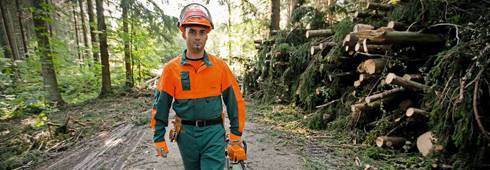
Along with clothing, you should wear a special helmet, headphones, and face and hand protection. To protect your legs from cutting, it is best to choose tight-fitting pants. For the same purpose, you need to choose shoes with a stable sole and a steel toe.
Chainsaw maintenance
Chainsaw care includes:
- kept clean and dry;
- timely adjustment of all components and assemblies;
- replacing worn parts with new ones.
It is necessary to regularly maintain the chainsaw by performing the following operations:
- adding a fuel mixture and oil to lubricate rubbing surfaces;
- regulation of chain tension, which lengthens over time;
- lubrication of the driven tire sprocket;
- blowing or washing the air filter;
- cleaning the cylinder combustion chamber;
- replacement of the chain, guide bar and drive sprocket upon abrasion of more than 0.5 mm from the nominal dimensions.
If it is necessary to stop working for a long period of time, all parts of the chainsaw are thoroughly cleaned
. In this case, the metal parts are coated with lubricant, and the chain is removed and immersed in oil. The fuel must be drained. It is recommended to store such a tool in a warm and dry room.
Following the rules listed in this article will help you operate your chainsaw efficiently and safely during the service life provided by the manufacturers.
It would seem that nothing could be easier than starting a chainsaw and working with it. But, as in any process, there are many pitfalls here. Follow safety precautions, and starting a chainsaw will not be something supernatural for you. Accordingly, each type of saw comes with a manual that must be read before starting work. The instructions describe everything in great detail on how to use the saw, how to prepare it for work and how to start it. You need to be very careful about the concept of running in a chainsaw. For two-stroke engine tools such as chainsaws, the concept of break-in does not exist.
Before starting the chainsaw, be sure to check the engine brake. It must be turned on.
By running in the engine we mean running the engine in a gentle mode for the first two to three hours. The work should not be carried out at maximum speed; you should not immediately cut heavy material, thick trunks and logs. During the first hours of a new tool, you can cut branches, twigs, and softer wood so that the new parts get as comfortable as possible with each other. Good modern chainsaws are made in such a way that they cannot tolerate prolonged idling; therefore, if the saw is not currently in use, the engine must be stopped.
User guide
Operating instructions for the Stihl saw:
- Saw monitoring is the most reliable safety equipment;
- Operation of the chainsaw should begin after a break period (break periods from 5 to 7 hours); until a breakdown occurs, it is forbidden to operate the saw at maximum speed - only under moderate load conditions;
- Be sure to turn off the chainsaw before putting it down;
- Before starting work, make sure that the chainsaw is in good working order;
- The mixing ratio of oil and gasoline is 1:40, this proportion is recommended for the most efficient operation of the engine, dilute gasoline with oil in the correct ratio, according to the instructions;
- You need to refuel your chainsaw with fresh fuel every four weeks;
- Make cuts according to the instructions - longitudinally or sideways of the bar, do not try to put pressure on the saw blade while working, but only orient the chainsaw.
Service:
- Every day, in accordance with maintenance standards, the device is checked for damage, the air filter is cleaned, tires and chains are lubricated, the condition of the spark plug, ignition system, fuel filter is cleaned once a month, a fresh fuel mixture is prepared, and the carburetor is adjusted annually;
- The chain should be tightened when it is loose, if the chain is dull and cannot be sharpened, replace it with a new one, the chain tension is adjusted by a bolt on the outer side edge of the chainsaw body. To sharpen the chain, you can use a special machine or contact a specialist.
READ Carburetor Adjustment for Champion 137 Chainsaw
What fuel should I use for my chainsaw?
Choosing the right fuel is an important and significant issue. The only correct approach to solving it is to carefully study the user manual, which indicates the type and brand of fuel, the mixing proportions of gasoline and oil, and also reflects all the features of this tool. Modern standards require the use of high-octane refined fuel and special types of motor oil.
Gasoline selection
Many people are interested in what gasoline a chainsaw works best with. Most models require clean, high-quality fuel with an octane rating of no higher than 90. Sometimes online there are recommendations to mix 92 or 93 gasoline with 95 to increase its efficiency. This should not be done under any circumstances, since higher octane brands are often counterfeited, and no one will dilute the A92 or AI92 brands.
Therefore, when choosing what kind of gasoline to pour into a chainsaw in the domestic market, it is recommended to use just such fuel. It is necessary to ensure that gasoline is sufficiently fresh, since during long-term storage it begins to release resins and other elements that impair quality. Manufacturers recommend using:
- Chainsaw Stihl (Stihl) 180 - it is better to fill with gasoline grade A90 and higher;
- Shtil 250 - runs on gasoline with an octane rating of at least 90. Do not use fuel with an ethanol content exceeding 10%;
- Partner - you must use only unleaded gasoline with an octane rating of at least 90;
- Husqvarna - gasoline with an octane number of at least 90; it is allowed to use pure fuel or with the addition of tetraethyl lead. Engines with a catalyst require the use of a fuel-oil mixture of unleaded gasoline.
As a rule, owners of such tools use AI92 gasoline, which fully meets the manufacturers’ requirements. However, for most domestic chainsaws A72 or A80 gasoline is quite suitable. It is also necessary to keep in mind that failure of the chainsaw due to the use of low-quality fuel is not a warranty case.
Oil selection
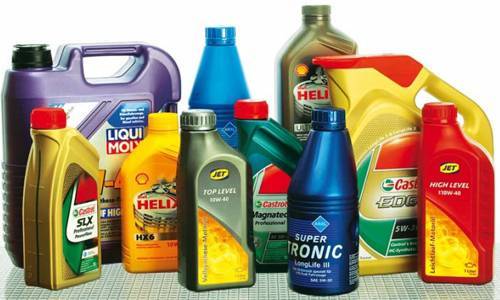
The chainsaw uses two types of oil - motor and chain (adhesive) oil. They should not be confused because the tasks they perform are different from each other. Any gear oil can be used to lubricate the chain, although manufacturers always recommend using materials of the same name. The requirements for motor oil are stricter. All manufacturers are unanimous on this issue - you should use oil from the same company that manufactured the saw.
Two-stroke engines do not have a lubrication system, which is replaced by the presence of some material in the fuel. The carburetor injects fuel and oil mist, which simultaneously lubricates all parts. After this, the residues are burned in the cylinder. If there are no specific instructions in the instructions, any two-stroke oil can be used.
For different tool models, manufacturers recommend:
- for chainsaw Shtil 180 - the best option is STIHL HP, HP SUPER or HP ULTRA oil;
- Calm 250 - correctly use STIHL HP, HP SUPER or HP ULTRA oil; STIHL HP ULTRA oil demonstrates the greatest efficiency;
- Partner - any two-stroke oil. It is forbidden to use automobile or marine oil, this will lead to engine failure;
- Husqvarna - the manufacturer recommends using HUSQVARNA two-stroke oil. Do not use oil for four-stroke engines or two-stroke water-cooled engines.
Starting without a starter
Often, many home craftsmen are interested in whether it is possible to power a chainsaw without the help of a starter.
The answer is very simple: this cannot be done in principle. None of the manufacturers have provided other alternative starting methods. Therefore, even if you remove the starter and try to start the car in some other way, it still will not work, since disturbances will occur in the cooling system. This system contains a volute to transmit the flow of cold air from the flywheel impeller towards the cylinder. If it is not there, the engine will overheat and eventually seize.
Reasons why the chainsaw does not start
The tool must be launched strictly according to the instructions. But if you have completed all of the above steps, and the saw still does not start, this means that there is something wrong with it. There are several reasons why it may not start:
- no spark;
- fuel is not supplied;
- air filter clogged.
So, what should you do to identify the real reason why the tool is not working?
Firstly, it must be said that if the tool does not start, the screws on the carburetor must under no circumstances be turned. And if you are not a professional in this field, then do not even try to adjust anything with your own hands or try to start the instrument.
The steps listed below, necessary for the tool to start working, must be performed in the strictly specified sequence. You need to start performing the next step only when the previous one did not work. The actions are:
- At first, you can try simply not doing anything with the tool for at least 5-10 minutes. There is a possibility that the spark plug was flooded during starting, which sometimes happens. Wait, then try again following the instructions;
- Try removing the tool housing cover, then remove the air filter from there, and try starting the saw without it. If the filter becomes dirty, wash it in soapy water, then dry it or replace it with another one;
- Unscrew the spark plug and check if there is a spark. If it is missing, then you can try installing another one. If a spark does not appear in the end, this indicates that the ignition unit is damaged and the tool needs to be repaired. If there is still a spark, but you still can’t start the chainsaw, proceed to the following steps;
- If there is a spark, but the spark plug is wet, then the chainsaw needs to be turned over. Thanks to this, excess gasoline will pour out of the cylinder, if there was any there. You need to pull the starter without a spark plug about 10-15 times, this will allow you to ventilate the combustion chamber. Fire up the spark plug and then screw it back in. If possible, change it to another one, try starting the tool again;
- If the spark plug is dry, then you need to take a syringe and fill it with one or two cubes of the gasoline mixture, then pour it into the cylinder. Try to operate the tool again. There is a possibility that a small speck has entered the carburetor and is preventing fuel from entering the combustion chamber. Such a speck can be pulled out using the flow that is formed after starting the machine by adding fuel directly to the cylinder itself;
- Unscrew and remove the muffler. But at the same time, try not to damage the gasket between the engine and the muffler. Once again we try to start the chainsaw without an air filter and muffler. When it is not there, you can study the piston from the inside. If there are burrs or burrs on the piston or on the cylinder walls, or if the piston ring is pinched by burrs, then this indicates that the piston is worn out or broken. This often happens if you don’t add enough oil to the fuel mixture. In this case, the only way out is to take the tool to a service center or buy a new one, since replacing the piston will be much more expensive.
The above material discussed how to properly start a chainsaw using the example of one of the Calm models, as well as how to behave if the tool cannot start. If you are new to this business or are faced with a problem, then this information may be useful to you in the future.
Reasons why a chainsaw may constantly pull to the side
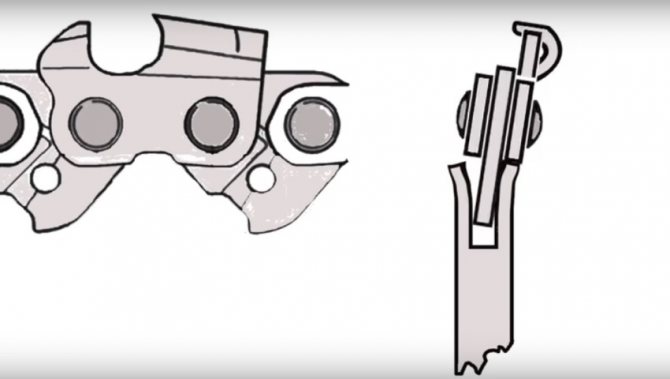
If, while cutting wood, the chainsaw is constantly pulled to the sides, this significantly affects the quality of the comfort of working with this equipment. In the presence of such a defect, the level of productivity decreases and the consumption of fuel used increases.
In addition, when the chainsaw is pulled to the side during a cut, the result is a crooked, poor-quality cut on the tree. There are several reasons why such a defect may appear.
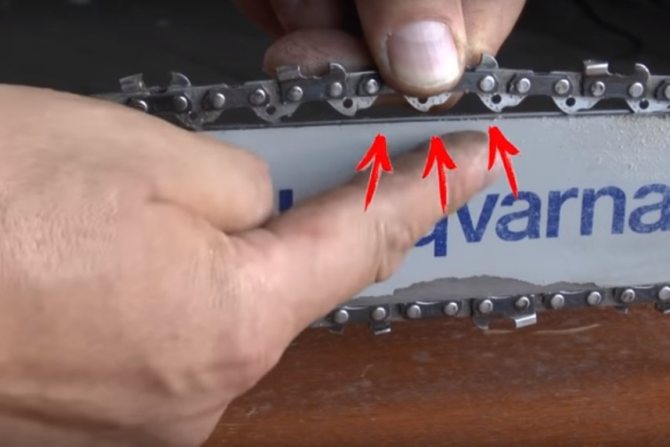
As a rule, such a deviation to the side when sawing wood appears as a result of:
- uneven sharpening of teeth located on the chain;
- when using a chain that does not fit the bar in size, or vice versa - when the saw set is too large for the chain;
- incorrect, uneven chain tension;
- severe wear of the saw set or chain used.
As a rule, the chainsaw begins to sharply move to the side during work due to uneven wear of the teeth on the chain used for cutting wood.
Most often, such wear appears as a result of the chain getting into contact with some hard object (nail, stone, etc.) while cutting wood. In this case, it is recommended to replace the chain used for cutting trees. Otherwise, when using a chain with a similar defect, the tire may fail.
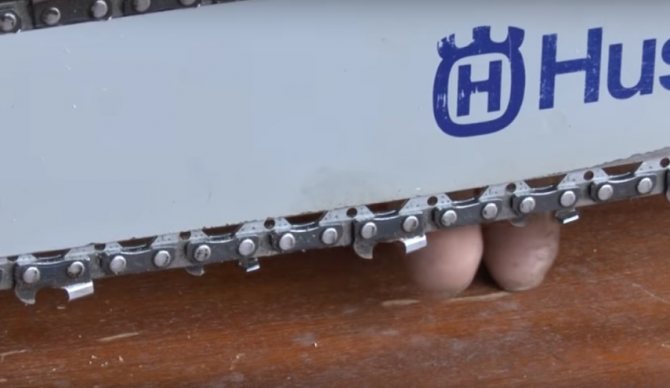
Also, very often chainsaws, when performing work and sawing wood, are pulled to the sides when the chain tension is incorrect or untimely. According to generally accepted instructions, it is necessary to tension and install the chain in such a way that only 3 shanks are clearly visible during lifting.
If the chain is tensioned on a cold chainsaw, you need to make sure that it does not sag after installation. Also, turning the chain directly on the tire itself when the tool is turned off should be done with one hand without using much physical force.

When working with a chainsaw, you must also take into account the fact that during sawing the chain begins to get very hot. As a result of such sudden heating, it begins to sag. Therefore, when sawing trees, the chain on the bar does not need to be pulled tight. Otherwise, after cooling it will begin to shrink and become overtightened.
It is not recommended to work with an overtightened chain, as in this case the tire itself will become very hot and deformed.
As a result, the tool will be carried to the side when performing work. In addition, working with a deformed saw set accelerates the level of wear on the chainsaw mechanisms.
